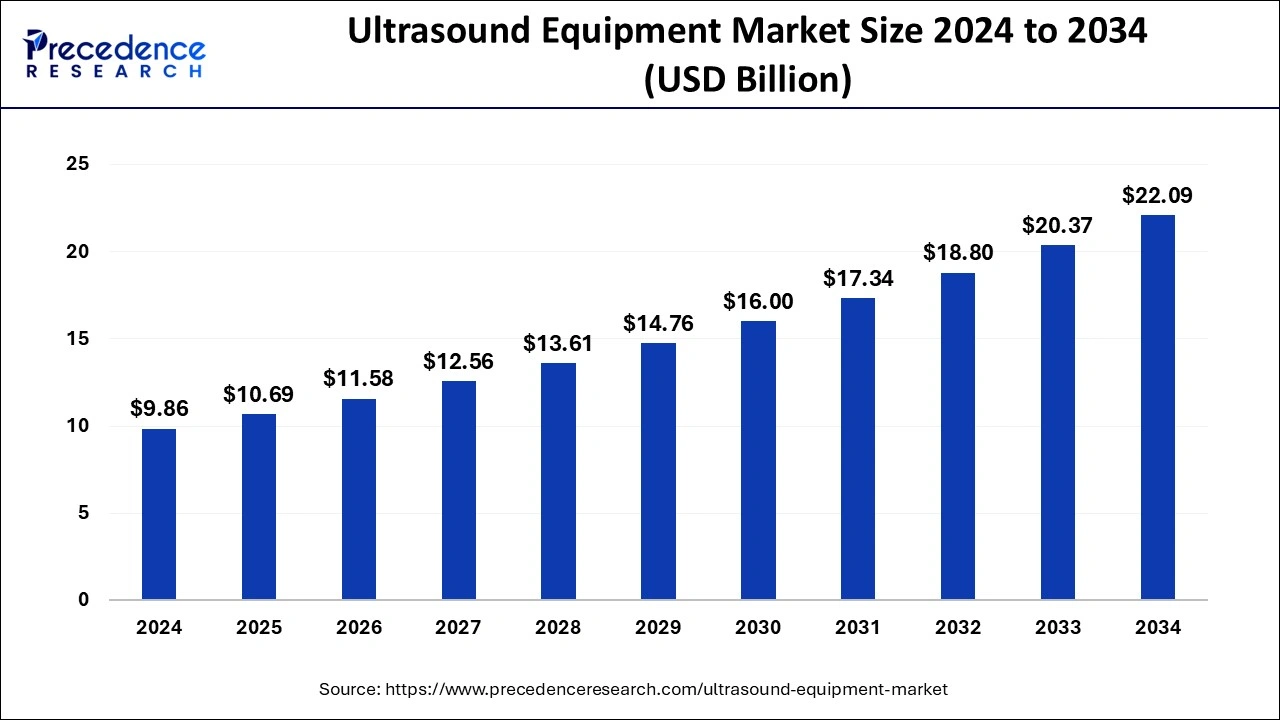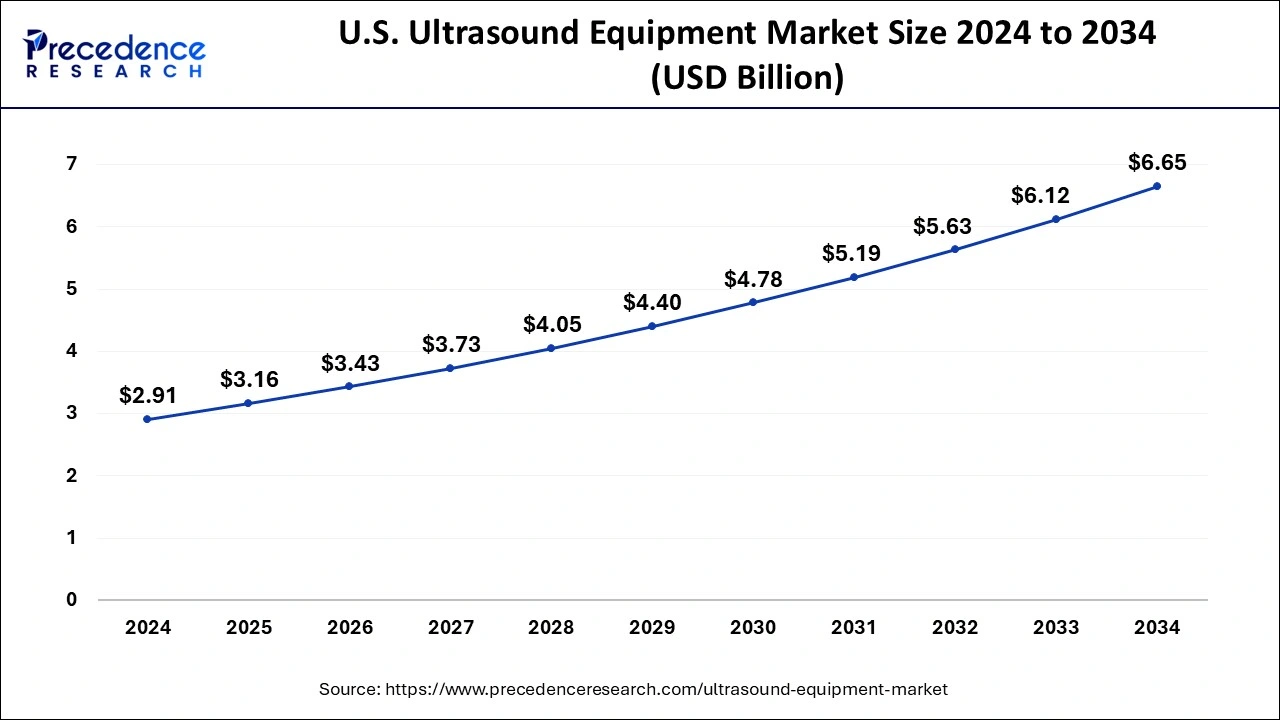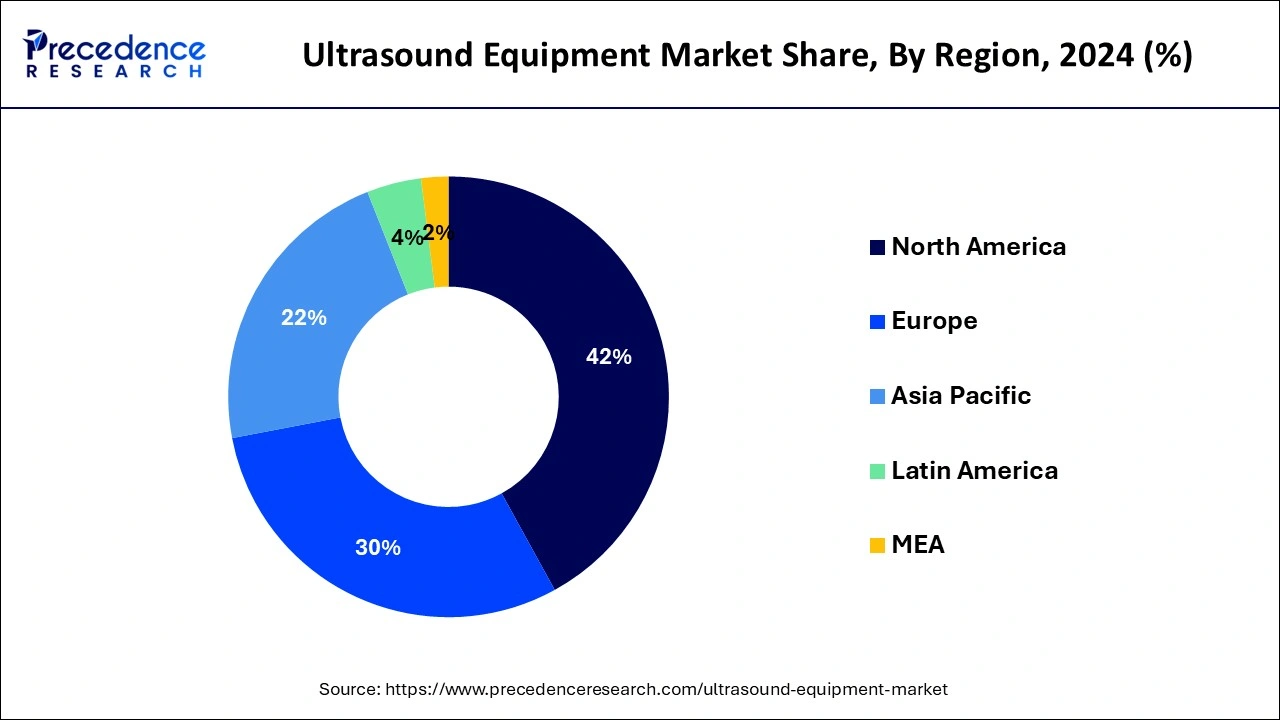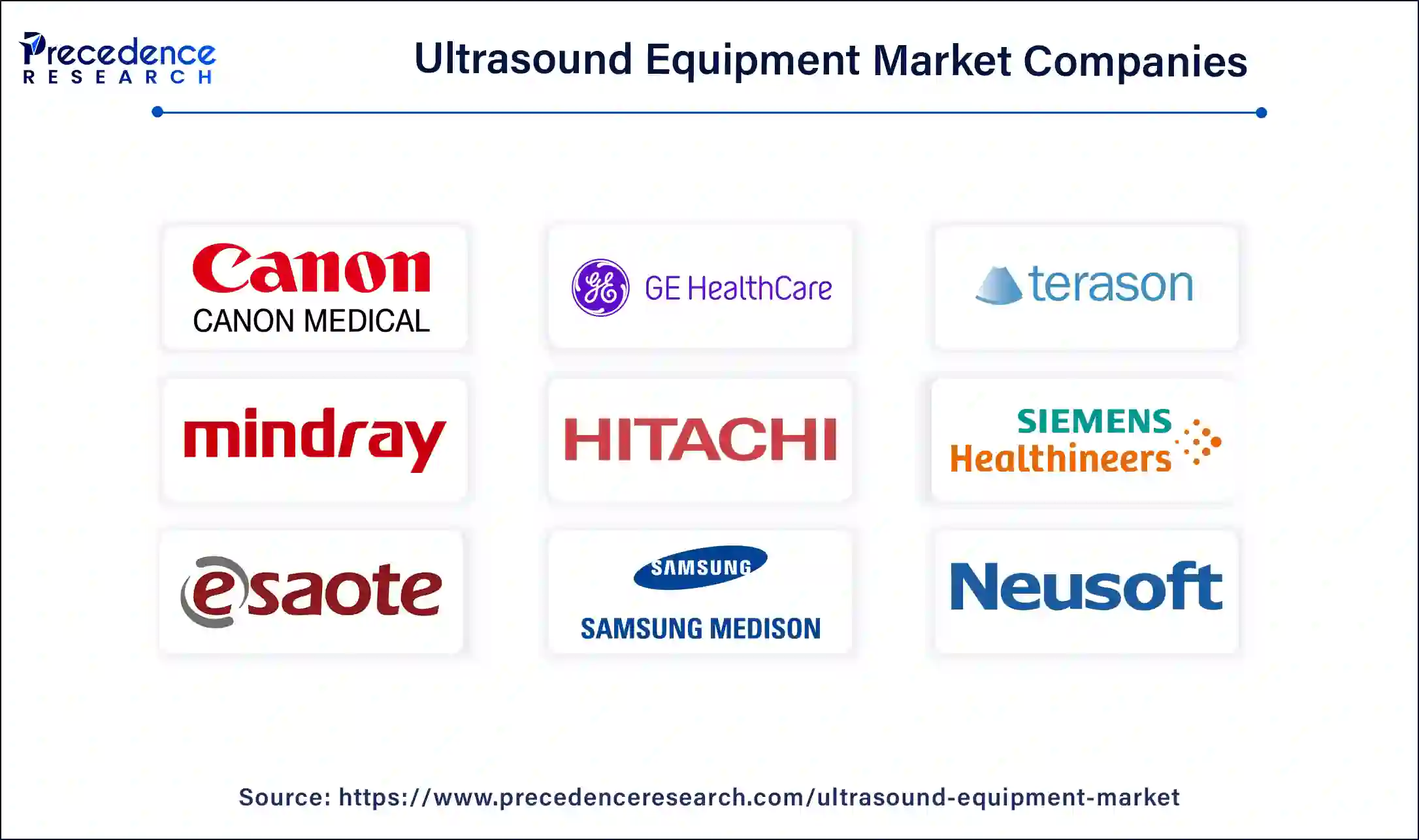List of Contents
What is the Ultrasound Equipment Market Size?
The global ultrasound equipment market size is calculated at USD 10.69 billion in 2025 and is predicted to increase from USD 11.58 billion in 2026 to approximately USD 23.71 billion by 2035, expanding at a CAGR of 8.29% from 2026 to 2035.The rapidly expanding diagnostics sector, rising incidences of chronic disorders, and increasing investments boost the market.

Ultrasound Equipment Market Key Takeaways
- North America led the global market with the highest market share of 42% in 2025.
- By Product, the table-top segment has held the largest market share in 2025.
- By End User, the hospital's segment captured the biggest revenue share in 2025.
- By Application, the radiology segment is expected to grow at a remarkable CAGR during the forecast period.
- By Application, the gynecology segment is expected to expand at the fastest CAGR over the projected period.
Impact of AI on the Ultrasound Equipment
Artificial intelligence (AI) finds immense potential in the diagnostics sector. Several researchers are investigating the role of AI in ultrasound equipment. AI can aid in easy analysis and interpretation of the imaging data. This can reduce manual errors, increase sensitivity, specificity, and accuracy, and save time for physicians. It can enhance the quality of ultrasonographic images, providing diagnostic support and improving workflow efficiency. AI can also be used to standardize image acquisition and integrate clinical information. It can also provide performance feedback for operators with integrated clinical information and demographics. AI-enabled ultrasound equipment can increase access to large amounts of patients globally, where access to trained sonographers is limited.
Market Overview
An ultrasound is an equipment that captures images of the organs inside the body to examine them. It is based on sound waves to capture the image of the body's internal organs, fluids, and soft tissues for testing, diagnosis, or therapeutic purposes. It enables healthcare professionals to diagnose problems associated with internal organs and to examine the sources of inflammation or pain in the body. Unlike X-rays and CT scans, they do not emit ionizing radiation. The ultrasound equipment comprises a transducer, central processing unit, display, control knobs, keyboard, and printer. The ultrasound image is produced based on the reflection of the waves of the body structures. This equipment finds immense applications in obstetrics and gynecology, urology, cardiology, biopsy, and probing.
Ultrasound Equipment Market Growth Factors
- Rising Incidences of Chronic Disorders: The rising incidences of disorders such as gastrointestinal, gynecology, urology, etc. necessitate the demand for ultrasound equipment for diagnosis.
- Increasing Geriatric Population: The geriatric population is more prone to chronic and other disorders requiring ultrasound equipment.
- Growing Demand for Diagnostics: Early detection of a disease is of prime importance in governing market growth.
- Technological Advancements: Advanced technologies drive the latest innovations leading to the development of cost-effective equipment.
- Growing Research and Development: The growing research and development activities lead to continuous improvements in the machine.
- Increasing Investments: The increasing funding by government and private organizations supports the installation of ultrasound equipment in medical facilities.
- Favorable Government Policies: Favorable government policies for early detection of diseases and improved diagnostics augment market growth.
- Suitable Regulatory Framework: Regulatory agencies across the world define regulatory guidelines for the market approval of innovative ultrasound equipment.
Market Scope
| Report Highlights | Details |
| Growth Rate from 2026 to 2035 | CAGR of 8.29% |
| Market Size in 2026 | USD 11.58 Billion |
| Market Size in 2025 | USD 10.69 Billion |
| Market Size by 2035 | USD 23.71 Billion |
| Largest Market | North America |
| Fastest Growing Market | Asia Pacific |
| Base Year | 2025 |
| Forecast Period | 2026 to 2035 |
| Segments Covered | Product, End User, Application, and Region |
| Regions Covered | Asia Pacific, North America, Europe, Latin America, Middle East and Africa |
Market Dynamics
Drivers
Increasing Pregnancy Cases
Ultrasound equipment is predominantly used in pregnancy to evaluate the condition of the fetus. According to the WHO, 41.3 women per 1000 women gave birth in 2023 globally. The increasing cases of pregnancy can also be due to early marriages of adolescent girls. The ultrasound images help to check the baby's development, the presence of multiple pregnancies, and to pick up any abnormalities during the pregnancy. The ultrasound equipment is non-invasive, painless, and safe for both the mother and the fetus, hence widely used during pregnancy. The number of ultrasound scans during pregnancy varies depending on the health of the patient. However, it is regulated to offer ultrasound scans at least 2 times during pregnancy.
Restraint
Lack of Trained Professionals and High Installation Cost
The major challenge of the ultrasound equipment market is the lack of trained professionals. This limits access to ultrasound imaging by numerous people, especially in low- and middle-income countries (LMICs). Around 50% of pregnant women in LMICs do not receive ultrasound scans through the full course of their pregnancy. Another major challenge is the high installation cost of the equipment. The high cost is not limited to installation but also extends to timely maintenance of the equipment. Both these factors restrict the use of ultrasound equipment, hindering market growth.
Opportunity
Growing Demand for Point-of-Care Diagnostics
The growing demand for point-of-care diagnostics creates ample opportunities for the ultrasound equipment market players. Point-of-care diagnostics are devices that can diagnose a disease at a patient's bedside, eliminating the need for healthcare professionals. The growing demand for home healthcare services potentiates the demand for point-of-care diagnostics. Ongoing research and development activities are carried out to develop point-of-care ultrasound (POCUS). The need for POCUS increases due to its portability and cost-effectiveness. POCUS can deliver the same accuracy and precision as that of conventional equipment. The post-pandemic era has also created a buzz for point-of-care diagnostics. Several government organizations also release guidelines to support the development of point-of-care diagnostics.
Segment Insights
Product Insights
The table-top segment accounted largest revenue share in 2024 and is estimated to sustain its dominance during the forecast period. This is attributable to the increased adoption of table-top ultrasound equipment in the healthcare sector owing to its low cost as compared to that of compact ultrasound equipment. The segment is expected to grow further owing to the rising government expenditure in developing economies to build hospitals to improve the healthcare sector.
On the other hand, the compact segment is anticipated to register the highest CAGR during the forecast period. This can be attributed to the enhanced features of the compact ultrasound equipment such as instant and accurate ultrasound results, safety, improved radiation-free imaging, and non-invasiveness. These features are considered to be boon in emergency settings and thus the adoption of compact ultrasound equipment is expected to register a significant growth in the forthcoming years.
End User Insights
The hospital's segment dominated the largest revenue share in 2024 and is projected to witness notable CAGR during the forecast period. This can be attributed to the extensive use of ultrasound equipment in hospitals across the globe. Ultrasound equipment is a boon in the diagnosis of various chronic diseases and hence is widely used across hospitals. Moreover, the rising number of patients and hospital admissions is perfectly complementing the growth of this segment.
On the other hand, the clinics segment is estimated to be the fastest-growing segment. The rising demand for the diagnosis of various diseases is fostering the growth of clinics. According to the CDC, in 2019, there were over 900 million physician visits in the U.S. Further, the rising penetration of private clinics in the developed and developing economies is a major factor fueling the growth of this segment.
ApplicationInsights
The radiology segment accounted largest revenue share in 2024 and is anticipated to hit a notable CAGR during the forecast period. There are various factors that fuel the demand for radiology such as the growing geriatric population and rising prevalence of diseases such as cancer and cancer survivors. Furthermore, developing economies are expected to drive the demand as developing economies hold vast potential for expansion in the healthcare sector.
On the other hand, the gynecology segment is estimated to register the highest CAGR during the forecast period, owing to the increasing usage of ultrasound diagnosis during pregnancy. According to NCBI, the average number of ultrasound diagnoses performed during pregnancy has increased from 1.5 in 1995 to 2.7 in 2006, in the U.S. There are several complications related to pregnancy, reproductive system, and fertility that needs to be diagnosed by the ultrasound systems.
Regional Insights
What is the U.S. Ultrasound Equipment Market Size?
The U.S. ultrasound equipment market size is exhibited at USD 3.16 billion in 2025 and is projected to be worth around USD 7.15 billion by 2035, growing at a CAGR of 8.51% from 2026 to 2035.

North America dominated the market in terms of revenue and is projected to surpass remarkable CAGR during the forecast period. This can be attributed to the increased adoption of advanced systems and technologies in the healthcare sector of North America. The growing geriatric population in the US and the rising number of private clinics and hospitals are boosting the demand for ultrasound equipment in the region.

On the other hand, Asia-Pacific is estimated to be the most opportunistic market during the forecast period. The huge population, rising disposable income, increasing expenditure in health and wellness, and growing government investments in the development of sophisticated healthcare infrastructure is boosting the economy of Asia Pacific and the ultrasound equipment market players have huge growth potential in the untapped region of Asia Pacific.
North America
Favorable government policies and increasing investments fuel market growth in the US. The US Food and Drug Administration regulates the approval of ultrasound equipment in the country. The National Institute of Biomedical Imaging and Bioengineering (NIBIB) provides funding for research projects related to ultrasound.
Asia Pacific
The Chinese government takes suitable steps to promote the use of ultrasound equipment in the country. The growing healthcare expenditure and suitable regulatory framework boost the market. The rapidly expanding healthcare and medical device sector in China also augments market growth.
Value Cain Analysis
- Research and Development: Designing and implementing new technologies in ultrasound and improving the existing ones.
Key Players: GE HealthCare, Siemens Healthineers
- Clinical Trials and Regulatory Approvals: Testing ultrasound equipment under clinical conditions for safety and efficacy, and subsequently obtaining regulatory clearance for its marketing.
Key Players: GE HealthCare, Siemens Healthineers, Philips, and Canon Medical Systems
- Formulation and Final Dosage Preparation: This is a smaller-scale stage only for ultrasound equipment, which refers to physical products like pharmaceuticals but could, in a broad sense, imply final assembly and calibration of the devices so that they perform optimally.
Key Players: GE HealthCare and Philips
- Packaging and Serialization: Packaging of ultrasound devices so that they cannot be tampered with, and serialization to trace them, and also prevents any counterfeits.
Key Players: SoftGroup, ACG
- Distribution to Hospitals, Pharmacies: This would represent processes and systems that implement ultrasound equipment at the delivery sites of health districts and possibly point-of-care settings like pharmacies.
Key Players: UPS Healthcare, DHL Supply Chain, FedEx Healthcare Solutions
- Patient Support and Services: Includes offering training, maintenance, and technical support to healthcare providers and end-users to assure the best use and longevity of the equipment.
Key Players: GE HealthCare, Siemens Healthineers, and Philips
Ultrasound Equipment Market Companies

- Canon Medical Systems Corporation
- GE Healthcare
- Koninklijke Philips N.V
- Terason
- Mindray Medical International Limited
- Hitachi Ltd.
- Siemens Healthineers
- EsaoteSpA
- Samsung Medison Co., Ltd.
- Fujifilm Holdings Corporation
- Neusoft Corporation
- CHISON Medical Technologies Co., Ltd.
- Shantou Institute of Ultrasonic Instruments Co., Ltd.
- Konica Minolta, Inc.
- Hologic, Inc.
- Analogic Corporation
Latest Announcement by Industry Leaders
- Roland Rott, President and CEO of GE Healthcare, commented on its acquisition with Caption Health that the importance of AI to guide ultrasound users during examination is increasing. He also added that Caption Health's AI applications help enable reliable, consistent ultrasound examinations to deliver more precise diagnoses, improve treatment decision-making, and ultimately improve patient outcomes, leading to precision care globally.
Recent Developments
- In August 2025, Royal Philips launched Transcend Plus, a cardiovascular ultrasound system that offers FDA-cleared 2D and 3D image quality enhancements and AI-enabled clinical applications.
(Source: https://www.mobihealthnews.com) - In June 2025, Royal Philips launches Flash Ultrasound System 5100 POC, a breakthrough point-of-care ultrasound system designed for fast-moving needs in anesthesia, critical care, emergency medicine, and musculoskeletal imaging.
(Source: https://www.philips.com)
Segments Covered in the Report
By Product
- Table-top
- Compact
By End User
- Hospitals
- Clinics
By Application
- Gynecology
- Cardiology
- Radiology
- Urology
- Point of Care
- Surgery
- Others
By Region
- North America
- Latin America
- Europe
- Asia-pacific
- Middle and East Africa
For inquiries regarding discounts, bulk purchases, or customization requests, please contact us at sales@precedenceresearch.com
Frequently Asked Questions
Ask For Sample
No cookie-cutter, only authentic analysis – take the 1st step to become a Precedence Research client



